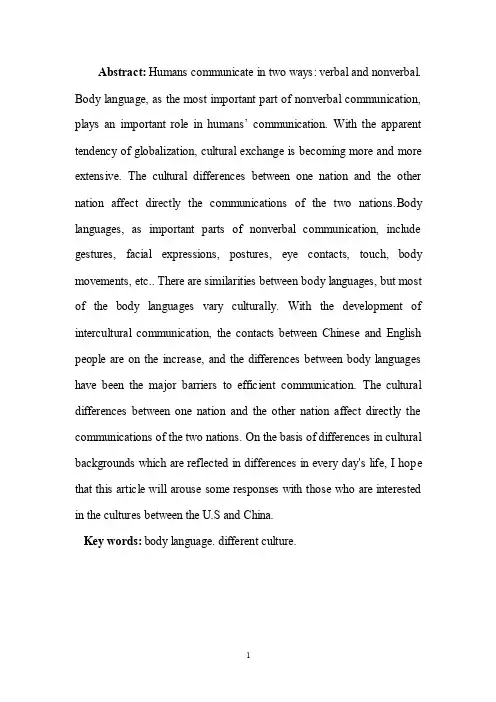body language 身体语言——文化差异
- 格式:ppt
- 大小:611.00 KB
- 文档页数:9


中美肢体语言对比different cultural, It follows that correct understanding and using the body language are most important, when we are cross cultural communication. This paper focuses on the comparative study of the body language in Chinese and American culture. And discuss the function of body language in communication.Key Words: body language; comparison; cultural difference ;intercultural communication;一、引言肢体语言 (body language)也称体态语言,是人类借助和利用自己的面部表情、手势动作、身体姿态的变化来表达和传递思想感情的方式。
运用自己的体态来表情达意几乎是人类自身的一种本能,因为它简便、迅捷、直观,在现实生活中的使用极其广泛,而且有时更能无声胜有声地巧妙表达信息并留给对方更大的想象空间。
除了微笑、哭泣等这些肢体语言不同文化含义相同外,不同文化相同的肢体语言意义可能迥然不同,因此,在与别的文化交流过程中,正确理解肢体语言的意义特别重要。
中美两国交往频繁,文化差异也很明显,肢体语言的使用也是如此。
二、探究和对比中美肢体语言的运用:(一)、面部表情语言的运用:面部表情是形体动作中最能表现人情绪的非语言行为。
达尔文说:“面部与身体的富于表达力的动作,极有助于发挥语言的力量.”法国作家罗曼.罗兰也曾说过:“面部表情是多少世纪培养成功的语言,是比嘴里讲的更复杂到千百倍的语言。
”心理学家阿尔伯特。
玛洛比恩发明了一个规则:总交流量=7%的文字交流+38%的口头交派+55%的面部表情交流。

中西方肢体语言的差异英语作文英文回答:Body language plays a crucial role in communication, conveying messages that words may not. However, cultural differences can lead to significant variations in the interpretation of body language, resulting in misunderstandings and even conflict. This essay will delve into the key differences between body language in Western and Eastern cultures.Eye Contact: In Western cultures, direct eye contact is generally considered a sign of sincerity, confidence, and trustworthiness. Maintaining eye contact while speaking indicates that you are engaged and attentive. However, in some Eastern cultures, prolonged eye contact can be perceived as aggressive or disrespectful. For example, in Japan, it is customary to avert one's gaze to show deference.Proximity: In Western cultures, there is a greater emphasis on personal space, and people tend to maintain a larger distance between themselves and others during conversations. Conversely, in many Eastern cultures, closer proximity is a sign of warmth and intimacy. For instance, in China, it is common to stand closer together and engage in more physical touch.Gestures: Gestures can convey a wide range of emotions and messages. However, the meaning of gestures can vary significantly across cultures. For example, the "thumbs up" gesture, which indicates approval in Western cultures, can be perceived as offensive in some Middle Eastern countries. Similarly, the "OK" sign, which represents agreement in the West, can be interpreted as an insult in Brazil.Body Posture: Body posture can communicate both physical and emotional states. In Western cultures, sitting or standing up straight is seen as a sign of confidence and alertness. However, in some Eastern cultures, a more relaxed posture may be considered more polite and respectful. For instance, in Thailand, it is considereddisrespectful to sit in a cross-legged position in front of an elder.Facial Expressions: Facial expressions are universal to some extent, but their interpretation can differ across cultures. For example, in Western cultures, smiling is generally associated with happiness and joy. However, in some Eastern cultures, smiling can also indicate discomfort or embarrassment. Similarly, the expression of anger may be more restrained in Eastern cultures, while it is more openly expressed in Western cultures.Cultural Context: It is important to note that body language should always be interpreted within its cultural context. What may be considered appropriate in one culture may be considered rude or disrespectful in another. For example, in Western cultures, it is common to shake hands as a greeting. However, in some Eastern cultures, it is more customary to bow or make a slight nod as a sign of respect.Understanding the cultural differences in body languagecan help avoid misinterpretations and facilitate effective communication. By being aware of these variations, individuals can adapt their nonverbal cues to the specific cultural context they are in, fostering betterintercultural connections and avoiding potential misunderstandings.中文回答:肢体语言在交流中起着至关重要的作用,它传达着言语无法表达的信息。



论文:从肢体语言看中西方文化差异Chinese and western cultural differences in body language一.引言二.肢体语言概述(一)肢体语言的概念及特征(二)肢体语言的相关理论三、肢体语言在差异文化中的发展与演变(一)肢体语言在人类社会交流方面的重要性1 不同种类的肢体语言所代表的意思2 肢体语言在交流中的作用以及重要性3 在中西方交流中,怎样恰当的使用肢体语言?(二)社群交流及族群认同性对区域文化历史的形成、发展的重大影响1中西方区域文化的历史的形成和发展对比2 中西方区域交流文化的重大差异(三)区域文化对肢体语言的反作用(四)中西方文化的主要内容和差异1 肢体语言对中西方交流文化的影响2 通过肢体语言对中西方交流文化造成差异的过程以及原因3 中西方交流文化中的肢体语言的比较以及异同四.肢体语言的东西方差异,在经济全球化带动文化交流融合的现代的发展趋势。
1 在中西方交流中学习肢体语言的必要性和重要性2 肢体语言在文化交流中的发展趋势五.结论1 General ideas of body languageA the definition of body languageB the relative theory of body language2 the development and exchange of body language in different culturesA the importance of body language in human ’s communication1. Introduction (1)2. The necessity and importance of learning body language on nonverbal communication (2)3. The concrete types and application of the body language (3)3.1 Types of body language (3)3.1.1 Distance between people conversing (3)3.1.2 Physical contact (3)3.1.3 Eye contact (4)3.1.4 Smiles and laughter (6)3.1.5 Gestures (6)3.2 Application of the body language (6)3.2.1 Greetings (6)3.2.2 Signs of affection (8)3.2.3 Physical contact in life (8)3.3 A comparative study of Chinese and American body language (9)4. Conclusion (12)Introduction1. General ideas of body language 52. ?The different kinds of body language 62.1 Manual speech2.2 face expression2.3 posture expression3. ?The function of body language4.How to use body language5. The importance of body language浅谈非语言交际中的身势语摘要“身势语”同语言一样,都是文化的一部分。

Abstract: Humans communicate in two ways: verbal and nonverbal. Body language, as the most important part of nonverbal communication, plays an important role in humans’ communication.With the apparent tendency of globalization, cultural exchange is becoming more and more extensive. The cultural differences between one nation and the other nation affect directly the communications of the two nations.Body languages, as important parts of nonverbal communication, include gestures, facial expressions, postures, eye contacts, touch, body movements, etc.. There are similarities between body languages, but most of the body languages vary culturally. With the development of intercultural communication, the contacts between Chinese and English people are on the increase, and the differences between body languages have been the major barriers to efficient communication. The cultural differences between one nation and the other nation affect directly the communications of the two nations. On the basis of differences in cultural backgrounds which are reflected in differences in every day's life, I hope that this article will arouse some responses with those who are interested in the cultures between the U.S and China.Key words: body language. different culture.Body Language in Lifeon Cultural Differences of Body Languages between Americanand ChineseChapter I Introduction生活中的身体语言—中美身体语言文化差异1.1 The definition of Body LanguageBody language, which includes gestures, facial expressions, posture, eye contact, touch, body movements and so on, is a most important part of nonverbal communication. It has five main communicative functions: repeating, complementing, regulating, contradicting and substituting. (Larry A. Samovar 2000:149) Body language should not be confused with the term nonverbal communication and gesture. The relationship between these three concepts can be illustrated by Figure 1.1.2 the Overview of Previous Studies of Body LanguageThe scientific study of body language can be traced back to the time of ancient Greece. The famous philosopher Aristotle first made an analysis on humans’ actions by which humans expressed their ideas and wishes. As time goes on, body language has developed into an several subject concerning biology, linguistics, sociology, pedagogy, political science and the most important of all, anthropology and communicative science. (Larry A. Samovar 2000:149)Since the 1950’s, many works on body language have appeared in the area of sociology and anthropology. Many anthropologists, such as American scholars Ray L. Birdwhistell and Julius Fast, basically focused their studies on the relationship between body languages and communication. In USA in 1959, Edward T. Hall published his book “The Silent Language”, which is taken as the first and foundational book of a new discipline“ Intercultural Communication”. The study of body language has become an important component of the discipline Intercultural Communication because of the significant roles it plays in communication and its cultural variations.On the one hand,the further sociological studies have proved that the body language plays an important role in humans’ communication. It is said that in theconversation , only 30% information is from the talk , the other messages are allconveyed by nonverbal means (basically body language). Psychologist Albert Mehrabian even proposed a formula: “the total effect of a piece of conveyed message =7% of words+38% of voice+55% of facial expressions” (Yang Zijian, 1990:577). On the other hand, scholars have found that body language is also a part of culture and is characterized by nationality. Its cultural variations already become a chief barrier to intercultural communication.Finally the paper puts forward three principles of studying cultural differences of body languages and proposes some concrete ways of introducing research achievements into foreign language teaching in order to help teachers and students understand the cultural connotations of body languages such as value system, moral standard, customs, historical background and mode of thinking of a nation and cultivate students’ all-round intercultural communicative competence.Chapter II Cultural Differences of Body Languages betweenAmericans andChineseAbout the cultural differences of body languages between English and Chinese, first of all, let us see the relationship between these two languages in the language families of the world illustrated by Figure 2.Figure2. the Language Families of the World (Larry A. Samovar 2000:149)The study of cultural differences can be conducted from various perspectives. To be general it can be conducted from the perspective of the East and the West; to be specific it can be conducted from the perspectives of race, nationality, national area, social rank, occupation, sex, age, environment, and it can even be conducted from the perspective of any two individuals. According to some scholars’ opinions such as Marshall Singe r—everyone’s cultural background is individual.2.1 Differences in ReligiousMost people in the U.S believe in Christianity, and Bible is the canon in the U.S. Its content includes creeds of Christianity. It is Bible that constitutes the U.S culture. Every American whether old or not, has to read Bible, and study it. Many English idioms come from Bible.In China, Buddhism and Taoism are the dominant beliefs. Confucius affected most Chinese people and society. Being united and self-surrendered are the points of Confucius, which plays the key role in forming Chinese culture.Take the gesture for praying for example (see Figure 3)Figure 3The gesture for swearing can serve as another typical example of the difference of religious beliefs. (See Figure 4)Figure4Figure 5There are still many other body behaviors varying culture in this category. For instance, almost everyone has the experience of pointing a way for others. Have you ever noticed the difference of making this gesture between people from different countries? This concept is also reflected in language. As we know, the Chinese idioms “指指点点”, “指手画脚” and “指桑骂槐” contain the derogatory sense. However, as for British or American people the name of the forefinger is “index finger”, so they do not think it is a rude gesture.Another similar example that can be presented is the gesture for beckoning someone to come (See Figure 6).Figure 6Body language can also be shaped by products of mind. It refers to the impact of works of philosophy, natural sciences and social sciences on body language.Take the well-known gesture for “victory” for example, which is now widely used all over the world (See Figure 7).Figure 7It is said kissing and hugging also come from the ancient Roman culture. In the ancient Rome women were not of equal social rank with men, so only men were allowed to drink. Thus when men came home, the very first thing he did was to smell his wife’s lips to check if she had drunk alone at home. After passing through many generations, this form of greeting used by ancient Roman husbands and wives has become modern etiquette between men and women.”Nowadays kissing can be given not only on lips, but also on cheeks, on hands .The way of kissing varies with the countries and the relationship between people.In USA, kissing is only among the opposite sexes or among women. To be specific, parents usually kiss kids’forehead; kids kiss parents’ lower jaw; friends, relatives, classmates or colleagues of the same generation often kiss each other on cheeks or just symbolically touch on cheeks; kissing on lips and hugging usually only take place between lovers or between husband and wife.and women even within the same family, it is easy to understand why the Chinese can hardly accept kissing or hugging in public as a form of greeting.The traditional Chinese form of greeting for men is bowing or making a short bow by clasping one’s hands before the chest (“作揖”); It is obvious that all these practices were possible to keep people from physical touching, however, nowadays these greeting forms are basically rare outside of movies depicting an earlier time.2.2 Different between Chinese and American Body LanguagesPeople from different countries have their own body language. Body language is a subtle pattern of conduct that can tell you more about the emotions and feelings in a situation than blunt verbal communication. Let's see how different Chinese and American body languages are. We will discuss the gestures, physical distances and the situation in business.First, there are some different gestures between China and America. They are bowing, nodding head, pointing and so on. In China, bowing is a common bod y language among students. When a teacher comes into the classroom and stands beside the desk, a monitor say " Stand up, please." When all the students stand up, the teacher will say, "Good morning, class." All students should lower their head slightly and say, "Good morning, teacher." When the class is over, the students also bow and say "Good bye" to the teacher. It means they respect the teacher. In China, A nodding head usually means, "Yes". But when a waiter or a waitress in a hotel nods his or her head, it is to acknowledge that you are there or to say "Hello" to you. Pointing at someone with the forefinger is an accusatory motion considered rude or hostile in China. When you point, use the entire hand and open palm. Also, it's impolite to point one's foot at another person. In contrast, America students rarely bow to their teacher. They wave a hand and say "Hello". It is very casual. Americans prefer pointing to objects and even at people with the index finger. But it seems impolite to Chinese. We have seen that some different gestures between China and America. And now we will see how distance is different between two countries. When people meet or talk to each other, Chinese and Americans are comfortable with different physical distances and levels of intimacy. Chinese people are conservative in their body language. They are shy and don't like showing their feelings publicly. They always keep their emotions under control. The only romantic hint is to hold hands with each other. They seldom kiss or hug each other in public. It is not uncommon for friends of the same sex to hold hands or clasp each other by the shoulder. If a man and a woman are intimate, people think they are lovers or couples. Unlike Chinese, Americans are ardent. They show their passion by hugging each other when they meet. In the same way, they kiss each other when they want to express love. They share their emotions directly. People don't feel strange when they see two people hug or kiss in America, because it is very common.Just now we discussed gestures and we know different levels of intimacy. Finally, we talk about the situations. In some situations, Chinese and Americans behave differently. In China, when a man and a woman meet in business, the man should offer his right hand to the woman to shake hands. The woman cannot offer her hand first. The man cannot hold a woman's hand more than a couple of seconds. And then the man also gives his business card with two hands to the woman first. The woman also uses two hands to receive it. Before they sit down at the table, the man will pull out his right hand and point to the seat. It means, "Please, sit here." On the other hand, Americans shake hands or hug each other in business. They shake hands formally. The man waits for the woman to offer her hand first. Also the man is very gentlemanly and pulls the chair out for the woman. After the woman sits down, he goes back to his chair and sits.In conclusion, different body languages represent different meanings in different places. Not only pointing, bowing and nodding head are different between China and America, American and Chinese people express their emotion in different ways and have different behavior in business. We should pay attention to the differences, in this way we can learn and understand each other.2.2.1 Body Language in AmericanIn the United States, people greet each other with a handshake in a formal introduction. The handshake must be firm (有力的). If the handshake is weak, it is a sign of weakness or unfriendliness. Friends may place a hand on the other’s arm or shoulder. Some people, usually women, greet a friend with a hug. Space is important to Americans. When two people talk to each other, they usually stand about two and a half feet away and at an angle (角度), so they are not facing each other directly. Americans get uncomfortable when a person stands too close. They will move back to have their space. If Americans touch another person by a ccident, they say, “Pardon me.” Or “Excuse me.” Americans like at to look the other person in the eyes when they are talking. If you don’t do so, it means you are bored, hiding something, or are not interested. But when you stare at someone, it is not polite. For Americans, thumbs-up means yes, very good, or well done, thumbs-down means the opposite. To call a waiter, raise one’s hand.2.2.2 Body Language in ChinaChinese stamp their feet (跺脚) to show anger; Americans interpret this as impatience. Chinese clap(鼓掌)For themselves after a speech. Americans may see this as immodest. When giving or receiving a gift, Chinese use two hands to show respect. Americans never even notice. Americans may pat other adults on the head to show sympathy, affection(喜爱)Or encouragement.This behavior could insult(侮辱)Chinese.Even laughter has the potential either to communicates or miscommunications. An American who fell off his bike was very angry when on-looking Chinese laughed at him. I myself was angered when my son fell down and bystanders(旁观者)Laughed. but I learned later that their laughter conveyed sympathy or understanding, not ridicule(嘲笑). American individuals value privacy and men always maintain a distance of 45-80 centimeters between them when they talk. To stand farther apart is inconvenient, to stand closer violates(违反)Body space.In American culture, frequent, prolonged (延长的) bodily contact between males suggests homosexuality (同性恋). Chinese males not only touch each other but also hold hands --- a practice that frightens western males.From the preceding chapter we can see that there do exist great cultural variations of body language, so the study of it is undoubtedly necessary. Nowadays it has been generally acknowledged that the final aim of foreign language teaching and learning is the acquisition of intercultural communicative competence. First of all, intercultural communicative competence is undoubtedly based on a good language proficiency referring to reading, writing, listening, speaking and translating. Is body language related to language? Of course, the answer is yes, because body language is a part of language. For example, according to Yang Xiaoli’s statistics, in Chinese idioms there are already 860 idioms concerning body language, such as 眉飞色舞,挤眉弄眼,昂首挺胸,俯首称臣,捶胸顿足,拍手称快,手舞足蹈,抓耳挠腮and so on. The right interpretation of the body language can contribute to the better understanding of work.this paper comes up with some basic approaches to introducing cultural differences of body languageChapter III ConclusionMost of the body languages vary from culture to culture. Due to this, its cultural differences already become the chief barriers to a successful intercultural communication. China and the United States are two great nations. One is the largest developing country and the other is the largest developed country. Although there are many different cultural parts existing, people between China and America have been friend for many yeas.More and more Chinese people go to the U.S for studying further or establishing new businesses or living permanently or just having visits. And more and more American people come to China for adventures and joys. The two nations' people have different cultures, but they can understand each other and accept these differences. Because they realize that there are some aspects which are new and good in the two cultures that are surely worth learning from to benefit each other's social construction and development. Cultural exchanges have played an important role in promoting mutual understanding and friendship between the two countries In order to get in-depth understanding of cultural differences of body language, we should try to combine our study with the cultural backgrounds it belongs to. The paper holds that on the one hand, we should make more studies on the cultural differences of body language; on the other hand we should try to introduce it into foreign language teaching, such as the causes Audio-Visual, Intensive Reading, Extensive Reading, Intercultural Communication and Translation, because studying and teaching the cultural differences of body language can help students better understand its culture background, improve their language learning, cultivate their all-round intercultural communicative competence and achieve a successful intercultural communication.AcknowledgementsIt was really a laborious task to accomplish a B.A thesis. Many people gave me support and help in the process of writing the paper. I’d like first to give my grate t o my dear teacher, Mrs. Li Xing DI. Who generously gave me his kindly help and instruction during the whole process of my paper writing? Then I’d like to give my many thanks to my friend who help me a lot with my information collecting and paper-polishing. Most important of all, I want to give my thanks to Mother University and all the teachers in the English College, who educated and cultivated me to be a qualified teacher in the future.Bibliography[1].Samovar·Larry A, Richard E·Porter and Lisa A·Stefani: Communicationbetween Cultures. Beijing Foreign[2].杨自俭,李瑞华. 《英汉对比研究论文集》. 上海:上海外语教育出版社,1990[3].He Guangkeng, the Basis of English Teaching and Learning Methods, Ji NanUniversity Press, 1999[4].Liu Yongfa, Liu Xuan'en, the Practical Body Language, Hua Wen Press, 1997[5].Wu Zongjie, Readings for Applied Linguistics and Language Teaching, ZhejiangTeachers' University, 1998[6].毕继万.《跨文化非语言交际》. 上海:外语教学与研究出版社,1999[7].杜保良等编著.《西方形体语速查》(英汉对照). 北京:北京理工大学出版社,200111。

从身体语言方面比较中西方文化差异作者: 电信学院.通信091班.李敏学号:200931003093摘要: 语言是社会的产物,是人类历史和文化的结晶.它凝聚着一个民族世代相传的社会意识、历史文化、风俗习惯等各方面人类社会所有的特征.不同的习俗传统和文化背影,使中西方在思维方式,价值观念,行为准则和生活方式等方面也存在着相当的文化差异.语言是文化的载体,词汇是文化信息的浓缩,身体语言是语言的重要组成部分,它反映着文化的发展和变化,同时也直接反映着文化的差异.同语言符号一样,身体语言是人们交流思想和传递信息的工具,是人类交际中常见的一种非言语交际手段,它与民族文化有着密切的联系.本文在较浅的层次方面探讨了身体语言在中西文化中所体现的不同文化意蕴及文化差异产生的根源.关键字:身体语言民族文化文化差异正文: 引言文化差异在异文化交际中常常被视为干扰源,许多时候会导致交际上的失误.其中最为突出的文化障碍因素之一就是非言语行为.因为”在与外族人交谈时,本族人对他们在语言和语法方面的错误往往比较宽容.与此相反,违反说话规则被认为是不礼貌的”(沃尔夫森).非言语行为中,对身体语言的不同理解又是产生交际失误的重要原因.1959年赫鲁晓夫访问完美国,在走上飞机旋梯时,为向美国人表示友谊,他做了一个将双手举过头顶鼓掌的手势.可这一手势使当时的许多美国人感到很不舒服,引起了不小的误会.因为把双手举过头鼓掌这一手势在俄罗斯人看来是友谊的象征,而在美国通常表示在战胜对手后骄傲、得意的意思.加之以前赫鲁晓夫曾说过要埋葬美国资本主义的话,许多美国人认为,这种手势表示他好像已经取得胜利而洋洋得意.一个小小的手势为什么会引起如此大的误会呢?这实际上是身体语言在不同民族的文化差异所引起的.进入新世纪后,在世界经济一体化和全球化的浪潮中,人际之间,民族之间乃至国家之间的相互交流和沟通日益频繁.中国的改革开放和加入世贸组织使得中西方文化交流越来越广泛、深入,由此彼此之间的文化差异而产生的文化碰撞乃至文化沟壑也不断出现.因此,了解世界各族的文化差异,尤其是中西方文化差异,培养对文化差异的敏感性,已经成为新时代的迫切要求.身体语言又称体语、身势语、体态语(body language),是指在言语行为过程中传递交际信息的面部表情和肢体动作,是非语言符号系统的一个重要分支.它同语言符号一样,执行着传达信息的交际功能,与人体纯生理性动作(如:因风刮进了沙子而眨眼)有重大差异.身体语言有目光接触、面部表情、姿势表达、空间语言、手语等多种表现形式.人类在进行交流、表达思想、传递信息时,除了使用语言进行传达外,大量的信息还依靠非语言符号.身体语言在传递信息和表达情感中具有语言所不能替代的功能.萨莫瓦曾说:“在面对面的交际中,信息的社交内容只有35%左右是语言行为,其它都是通过非语言行为传递的.”人们通过面部表情、手势、身姿等诸多无声的身体语言,将有声语言形象化、情感化、生动化,以达到先声夺人,耐人寻味的效果,且能充分弥补有声语言表达的乏力和不足,特别是人类在“词不达意”“只可意会不可言传”的情况下,身体语言就能发挥其独特的作用,圆满表达情意,达到”此时无声胜有声”的效果.身体语言在中西文化中的共同性和差异性是人体语言的表达及含义在不同民族中反映的结果.有些与生理本能有关的身体语言是人类长期积累起来的,在各民族中具有相同的意义,所传递的信息为不同文化、不同民族的人们所理解.如高兴时会张开嘴微笑,生气时会张大眼睛,痛苦时会皱眉等.因为人类的面部表情是天生的,人类交际的生理本能是相通的,不受文化制约的.除此之外,中西方在身体语言文化上还有很多其他共同之处,这是中西民族之间进行非言语交际的有利条件.如点头的语义是首肯,摇头表示否定,握手表示问候、祝贺、告别等.但是,中西方有各自的文化背景,在历史发展的过程中形成了各自的价值观和行为模式,对身体语言的表现形式和理解就不尽相同.首先,中西方人用不同的身体语言表达相同的意思.如:吃完饭后,中国人用手拍拍自己的肚子表示吃饱了.而美国人用一只手放在之间的喉头,手指伸开,手心向下,也表示吃饱了.肚子和喉头都与“吃”有关,它们形象、直观地表明了“吃后”的结果,在双方交际中很容易被理解.其次,同一身体语言在中西文化中表示的意义相同,但在表现程度上有所差别.中美两国人都用握手互致问候,但美国人还强调握手的姿势和力度.他们认为目视对方,有力地握手体现一个人自信、真诚、热情的心理状态.而中国人握手的力度常使他们感觉好像缺乏信心和热情.随着中西方交流的日渐增多,汉文化中的身体语言在一定程度上受到了西方文化习俗的影响.表示胜利的V字手势,拇指与食指相连形成环型,竖起其余手指表示”OK”的手势在年轻人中广泛使用.但中国传统文化仍然是根深蒂固的,具有相对的稳定性.再次,从身体语言中可以反映出中西方文化差异的根源.其中宗教文化尤为突出,宗教文化是社会文化的一个重要组成部分,它时刻影响着社会生活的方方面面,尤其在西方一些国家,宗教文化在社会生活中起着支配作用,它无形地影响人们的生活方式和认知方式.西方人大多信仰基督教,天主教,也有少数人信犹太教和伊斯兰教.英文化起源于古希腊文化,基督教文化是社会生活中的主流文化,它渗透到社会生活的各个方面.基督教认为:所有人都是上帝之子,个体具有至高无上的内在价值和尊严.因此他们的行为举止均从平等、自由之观念出发,人与人之间的关系呈横向结构,即平等的而非等级的关系结构.美国人在交谈时的姿势很随便,有时甚至半躺在椅子里,翘起二郎腿或将腿搁在桌子上与人交谈,人们也很少计较这些,这与他们崇尚自由平等的思想是分不开的.在中国人看来,这样的动作时缺乏修养傲慢无礼的表现.而在中国,儒家思想的统治长达两千年,尽管道教和佛教对中国文化产生了深远的影响,但强大的纲常伦理观念阻挡和淡化了宗教对国民意识的渗透.儒家思想所提倡的价值原则主要体现在重人伦轻自然、重群体轻个体、重利轻义、重道轻器,所以中国人一方面深受”贵贱有等,长幼有序,男女有别”等传统礼制的影响,另一方面表现出谦和礼让,举手抬足间都注重“仪态端庄”“举止得体”.尽管道教尊重人的自然潜能,追求个性自由,但在宗法制度的社会里很难成为中国传统价值观的主导方面.从这些方面都可以看出,中西方文化在语言方面就存在着如此多的差异.中国人尤其是古代中国人,在交际时所使用的身体语言带有浓厚的“自贬”色彩,体现了“自卑而尊大,贬己而尊人”的被视为汉文化的传统美德,而西方人追求个人主义,其核心是平等自由的思想,其基本要素是人的尊严、自由、隐私和自我发展.但是,无论哪方文化,一个民族的身体语言表达什么样的意思是约定俗成的.因此,我们在学习跨文化交际时,要充分了解中西方文化的差异,不要违反这些约定俗成德规则,否则会引起交际中断,甚至误解.我们还要深入了解双方文化的特点,民族心理和习惯,对身体语言在中西文化中的礼貌规范,要”入国问禁,入门问俗”.从而减少交际中断,避免交际失误.【参考文献】:1.胡文仲,《文化与交际》.北京外语教育与研究出版社.19942.许力生,《跨语言研究的跨文化视野》.上海外语教育出版社.20063.况新华,《论人体语言的交际功能及其文化性》.大连外语学院.20044..。


身体语言文化差异初论语言是人类最重要的交流工具,但语言之外的非语言的肢体信号对人类的交流也起着十分重要甚至是至关重要的作用。
美国心理学家阿尔伯特?麦拉宾认为:在一次面对面的交流中,一个人说话时给人留下印象和感觉,也就是交流的效果,语言占7%,声音占38%,肢体语言占55%。
换言之,人际间的交流,一半以上的信息是通过肢体动作传递的,在人际交流中占有如此重要作用的肢体动作,我们称为身体语言。
随着世界的交往日益频繁,无论国家层面的对外交往还是个体求学出行探亲访友的各种需求,言辞之外的非语言的影响,日益显现。
了解不同文化中身体语言的差异性,尊重并理解区别于自身习惯的身体语言信号,对于双方达成友好高效的沟通交流无疑是一种很好的渠道。
一、身体语言与文化的关系身体语言包括表情、动作、手势、触摸、界域(空间距离)、服饰等。
杨镇明先生1995年主编的《朗文当代英语辞典》对身体语言有过界定:身体语言是指人通过四肢运动或身体姿势的改变来展示人的所思所想。
对于什么是文化也有很多不同的说法:英国人类学家爱德华?泰勒在《原始文化》一书中,首次将文化表述为:“文化或文明,就其广泛的民族学意义来讲,是一复合整体,包括知识、信仰、艺术、道德、法律、习俗以及作为一个社会成员的人所习得的其他一切能力和习惯。
”人类学家吉琳与吉琳(GillinandGillin)说:“每一群体,每一社会,都有一套明显的或不明显的行为模式。
这些行为模式多多少少都是该群体的分子所共有的。
这些模式从上一代传到下一代,而且也常常会改变。
这些共同的行为模式我们叫做文化。
”上述关于文化的定义,说明文化是一个民族或集体特定的精神与物质符号,文化是一个民族或一个集体全部的生活方式。
身体语言作为文化的一部分,概莫能外。
身体语言藏着人类遗传的密码,是人类潜意识的表现,人类绝大多数身体语言的表达是完全一致的,具有普适性。
比如面部表情中,哀伤、喜悦、羞愧、愤怒、疑惑等情绪的表达在各个文化中基本一致。

身体语言文化差异初论语言是人类最重要的交流工具,但语言之外的非语言的肢体信号对人类的交流也起着十分重要甚至是至关重要的作用。
美国心理学家阿尔伯特?麦拉宾认为:在一次面对面的交流中,一个人说话时给人留下印象和感觉,也就是交流的效果,语言占7%,声音占38%,肢体语言占55%。
换言之,人际间的交流,一半以上的信息是通过肢体动作传递的,在人际交流中占有如此重要作用的肢体动作,我们称为身体语言。
随着世界的交往日益频繁,无论国家层面的对外交往还是个体求学出行探亲访友的各种需求,言辞之外的非语言的影响,日益显现。
了解不同文化中身体语言的差异性,尊重并理解区别于自身习惯的身体语言信号,对于双方达成友好高效的沟通交流无疑是一种很好的渠道。
一、身体语言与文化的关系身体语言包括表情、动作、手势、触摸、界域(空间距离)、服饰等。
杨镇明先生1995年主编的《朗文当代英语辞典》对身体语言有过界定:身体语言是指人通过四肢运动或身体姿势的改变来展示人的所思所想。
对于什么是文化也有很多不同的说法:英国人类学家爱德华?泰勒在《原始文化》一书中,首次将文化表述为:“文化或文明,就其广泛的民族学意义来讲,是一复合整体,包括知识、信仰、艺术、道德、法律、习俗以及作为一个社会成员的人所习得的其他一切能力和习惯。
”人类学家吉琳与吉琳(GillinandGillin)说:“每一群体,每一社会,都有一套明显的或不明显的行为模式。
这些行为模式多多少少都是该群体的分子所共有的。
这些模式从上一代传到下一代,而且也常常会改变。
这些共同的行为模式我们叫做文化。
”上述关于文化的定义,说明文化是一个民族或集体特定的精神与物质符号,文化是一个民族或一个集体全部的生活方式。
身体语言作为文化的一部分,概莫能外。
身体语言藏着人类遗传的密码,是人类潜意识的表现,人类绝大多数身体语言的表达是完全一致的,具有普适性。
比如面部表情中,哀伤、喜悦、羞愧、愤怒、疑惑等情绪的表达在各个文化中基本一致。
从肢体语言看文化差异摘要:跨文化交际中,中西方文化的差异和他们的思维模式的差异影响着人们相互之间的理解与交流。
学习英语过程中基本的语法词汇当然特别重要,但是肢体语言作为一种特殊的语言也不容忽视。
肢体语言(body language)是指能够传递某种特定信息的面部表情、手势语,以及其他身体部位动作。
其之所以能够被称之为语言,主要在于它的信息传递性。
为什么它有着不可忽视的作用呢?是因为有时肢体语言能够表达比话语还要深刻的含义或内容。
但是,每个人都有自已的一套肢体语言,而对于同一套肢体语言,每一种文化也有与其他文化不同的含义。
由于文化差异的缘故,对肢体语言的误解很可能会让你陷入尴尬的境地。
倘若忽视这些,人们就可能造成一些令人不快的严重错误。
所以,明智的做法就是你应该在对他人的肢体语言和动作下结论之前,首先考虑对方的文化背景,从而避免产生不必要的误会。
因此,提高对文化认知的程度,并通过研究了解肢体语言的差异,无疑具有十分重要的作用,进而使得沟通显得更加通畅无阻。
在这里我们就研究一下由于中西方不同的肢体语言含义的差异所隐含的文化差异。
关键词:肢体语言文化差异跨文化交际正文:肢体语言同语言一样,都是文化的一部分。
在不同文化中肢体语言的意义并不完全相同。
各民族有不同的非语言交际方式.例如:不同的民族在谈话时,对双方保持多大距离才合适有不同的看法;谈话双方身体接触的次数多少因文化不同而各异;在目光接触这一方面也有许多规定:看不看对方,什么时候看,看多久,什么人可以看,什么人不可以看;在某些场合下,在中国和讲英语的国家无论微笑还是大笑,通常表示友好﹑赞同﹑满意﹑高兴﹑愉快,但是在某些场合,中国人的笑会引起西方人的反感;打手势时动作稍有不同,就会与原来的意图有所区别,对某种手势理解错了,也会引起意外的反应等等。
因此,要用外语进行有效的交际,在说某种语言时就得了解说话人的手势,动作,举止等所表示的意思一、肢体语言”同语言一样,都是文化的一部分。
走进Body Language 感悟中外文化差异高一(14)班英语研究性学习小组【简介】本文通过网络搜索、查阅书面资料及电子文档、小组分工合作讨论、问卷调查等形式,结合英语与历史学科的特点,对世界各国的肢体语言进行了一系列探讨。
在研究中从多方面对肢体语言进行了学习,增加对肢体语言认知,提高对英语的兴趣,并了解肢体语言在不同文化背景下的不同的含义与社会功能,使我们在人际交往中能够成功地进行交流。
【关键词】中外文化差异人际交往社会功能一、摘要Body Language肢体语言,又称为身势语言,是表示使用身体运动或动作来代替或辅助声音、口头言语或其他交流方式进行交流的一种方式的一个术语。
它是副语言(Paralanguage)的一种类型,副语言包括各种形式的非口头语言的人类交流方式,包括不为人注意的最细微的动作,例如眨眼和眉毛的轻微运动。
肢体语言可以与面部表情结合使用。
(又叫肢体语言,是由人的四肢运动引起的,也可以传递许多信息。
握手是身体语言中最常见的一种。
)世界各国的肢体语言与语言和文化一样,也有相似之处。
然而,由于地域,种族,文化习俗的差异,不同文化的肢体语言有许多差异。
它们由文化制约并拥有独特的文化内涵。
二、研究过程1.开题报告(1)过程::①我们先询问老师开题报告的填写要点。
②小组成员各自谈谈对课题的理解。
③经过一番讨论后,确立了课题研究重点。
(肢体语言在不同文化下的差异)④顺利地完成了开题报告的填写。
(2)内容:班级:高一14班指导老师:黄玉霞课题组成员:陈嘉淼、魏燕敏、洪舜熠、林宇琳、曾乐佳、邱瑞玲、李芸、陈婧主要课程:英语相关课程:历史,电脑,数学研究时间: 2012.02~2012.05研究的主要方法:上网查阅资料,咨询老师,上书店查阅资料研究计划:<1>任务分工:①制定计划,研究方案④设计、统计调查问卷②收集资料(文字、图片等)⑤撰写开、结题报告③整理分析资料⑥撰写论文,活动报告<2>研究步骤:第一阶段:充分准备、制定计划第二阶段:写开题报告,收集资料第三阶段:设计调查问卷第四阶段:统计调查结果,整理分析资料第五阶段:模拟情景,学习肢体语言第六阶段:撰写论文、结题报告可行性分析:我们对该课题充满浓厚的兴趣,可运用课余时间多方面了解本课题所涉及的相关知识。
知识拓展:肢体语言与中西方文化差异肢体语言(body language)是指能够传递某种特定信息的面部表情、手势语,以及其他身体部位的动作等等。
它在人际交往过程中起着非常重要的作用。
由于社会的发展,国与国之间的交流不断加强,西方的许多肢体语言在我国也已经被认同,还有一些被普遍适用。
比如:西方人往往指胸口来表示“我”。
大拇指朝上,表示“好”;但大拇指朝下则表示“坏,糟透了”。
还有用大拇指指尖与食指指尖相接成O形,伸直其余三个指头,表示OK,即“正常”、“顺利”、“没问题”。
伸出食指和中指成V形,表示victory(胜利)。
如果招手示意别人过来,他们是伸出掌心朝上,捏拢四指,前后弯动食指。
当然,在中国和西方国家中,肢体语言其含义也存在不同程度上的差异。
不过,很多肢体语言表达的含义还是一致的,比如,点头表示:同意或者表示明白了,听懂了;眉毛上扬表示:不相信或惊讶;避免目光接触意味着:冷漠,逃避,不关心,没有安全感,消极,恐惧或紧张等;摇头表示:不同意;鼓掌:赞成或高兴等等,但是在这里,我们主要通过分类来说明,在不同的文化背景下,不同的肢体语言在不同程度上所存在的差异,了解从中体现出来的文化差异,从而提高我们学习语言的兴趣。
一、动作一样,意义不同(the same action,different meaning)。
如下例:1. 跺脚(stamp one’s foot):在中国人看来,表示气愤,恼怒,灰心,悔恨。
比如说:气得直跺脚。
而它的英文含义则是不耐烦,比如:give a stamp of impatience(不耐烦得跺脚)。
2. 目不转睛地看(look with fixed gaze):其中文含义是:好奇;有时是惊讶。
比如,孩子们目不转睛地盯着公园里的猴子;他目不转睛的看着科幻书上的飞碟等等。
而这个短语的英文含义则是不礼貌;使人发窘;不自在。
比如:Under his intense gaze she felt uncomfortable.(他目不转睛地看着她,使她觉得很不自在。